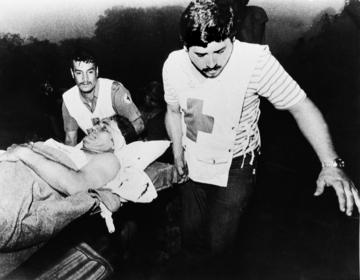Whoever was responsible for planting the bomb that killed seven people and left 21 wounded at a press conference 26 years ago at La Penca likely got away with it.
Any further official investigation on the attack that took place in a small Nicaraguan border community will officially lead nowhere, since Costa Rican authorities admit their inability to collect enough evidence to track down the bomber or any of the involved suspects, according to a letter sent last December by Costa Rica’s chief public prosecutor, Jorge Chavarría, to members of the Costa Rican Journalists Association (CRJA).
Now CRJA members say they will no longer appeal to Costa Rican authorities to solve the case. Instead, they plan on pushing forward a claim filed in 2005 with the Inter-American Commission on Human Rights (ICHR). That case charges the Costa Rica government with failing to take proper measures to guarantee prompt and effective justice for La Penca’s victims.
If enough evidence is gathered that proves Costa Rican authorities were negligent, then the ICHR will recommend the case to the Inter-American Court of Human Rights, where a final ruling will be issued.
The bombing happened on May 30, 1984, and is considered to be one of the darkest chapters in the history of Costa Rican journalism.
That day journalists from several news agencies attended a press conference held by Edén Pastora, the legendary guerrilla leader known as “Comandante Cero,” who years after a daring 1978 Sandinista takeover of Nicaragua’s congressional National Palace became a U.S.-sponsored rebel leader seeking to oust Daniel Ortega’s government in Nicaragua.
During the ill-fated press trip, journalists departed from Costa Rica to an undisclosed destination, and then on to a small hut in La Penca where the conference with Pastora was to be held. The press conference started at 7:15 p.m., and a few minutes later a deadly blast took the lives of several attendees, including Tico Times reporter Linda Frazier.
Over the years, several theories emerged about the attack’s perpetrator, or perpetrators. The most widely believed theory is that Roberto Vital Gaguine, an Argentine leftist who disguised himself as a Danish photographer named Peer Anker Hansen, planted the bomb.
Last year Peter Torbiornsson, a Swedish journalist injured in the massacre, told Costa Rican authorities that Tomás Borges, Nicaragua’s interior minister at the time, allegedly ordered Pastora’s execution, to take place during the press conference.
But that allegation may never be confirmed or proven false, according to Chavarría’s letter, which he sent to the CRJA on Dec. 23, 2010.
“There are no real possibilities of any further progress in this case in the near future, because the legal identity of the perpetrator has not been clearly established,” Chavarría wrote.
“It’s not right if nothing happens [with the investigation]. That’s like saying that the victims’ lives don’t mean anything,” said journalist Gilberto López, one of the survivors.
Like other survivors of the attack, López is convinced that no one will ever be prosecuted in the case. But if the case proceeds to the human rights court and the Costa Rican government is found to be negligent, members of the CRJA say they will sue the government.
“The veil of impunity will be cast over this case for centuries to come, but it is important to take this to international forums and provide victims with some sense of justice, even if it’s only monetary compensation,” said Nelson Murillo, a former journalist forced to retire because of his injuries.






